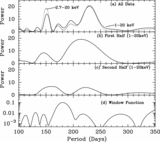GINGA All-Sky Monitor Observations of Cygnus X-1
Abstract
We report 1-20 keV monitoring of the black hole candidate Cyg X-1 by the Ginga all-sky monitor (ASM), in 339 observations spanning from 1987 February to 1991 October. Cyg X-1 was in the X-ray low state in the entire 4.5 yr period. Flux modulation at the 5.6 days orbital period was observed clearly (if we assume no periodic variation, reduced χ2 value is 7.1) in the low-energy (1-2.1 keV) band. In the higher energy band, the modulation amplitude was small and less significant. The 1-2.1 keV folded light curve is a smooth function of the 5.6 days phase. These facts suggest that the modulation is caused by the orbital variation in the column density of photoelectrically absorbing circumstellar matter, as might be expected from the wind of the companion O9.7 Iab star, HDE 226868. The analysis of the spectral modulation suggests that the absorbing wind is not homogeneous. The ~300 days periodicity, reported previously by the Vela 5B investigators, was studied. Approximately 150 days periodicity, rather than ~300 days, was suggested in our data. Also, a broad peak around ~210-230 days period was found in both the power spectral density and the epoch-folding analysis. These periodicities seem to be unstable in their periods. The time-averaged 1-20 keV spectrum from the Ginga ASM alone can be characterized by a power law. However, the combined spectrum measured by Ginga in the 1-20 keV range and by the Solar Maximum Mission (SMM) hard X-ray and burst spectrometer (HXRBS), in the 25-400 keV range in 1987-1988 would require a more complex model, such as the unsaturated Comptonization model.
- Publication:
-
The Astrophysical Journal
- Pub Date:
- March 2000
- DOI:
- Bibcode:
- 2000ApJ...531..546K
- Keywords:
-
- BLACK HOLE PHYSICS;
- STARS: INDIVIDUAL: CONSTELLATION NAME: CYGNUS X-1;
- X-RAYS: STARS
